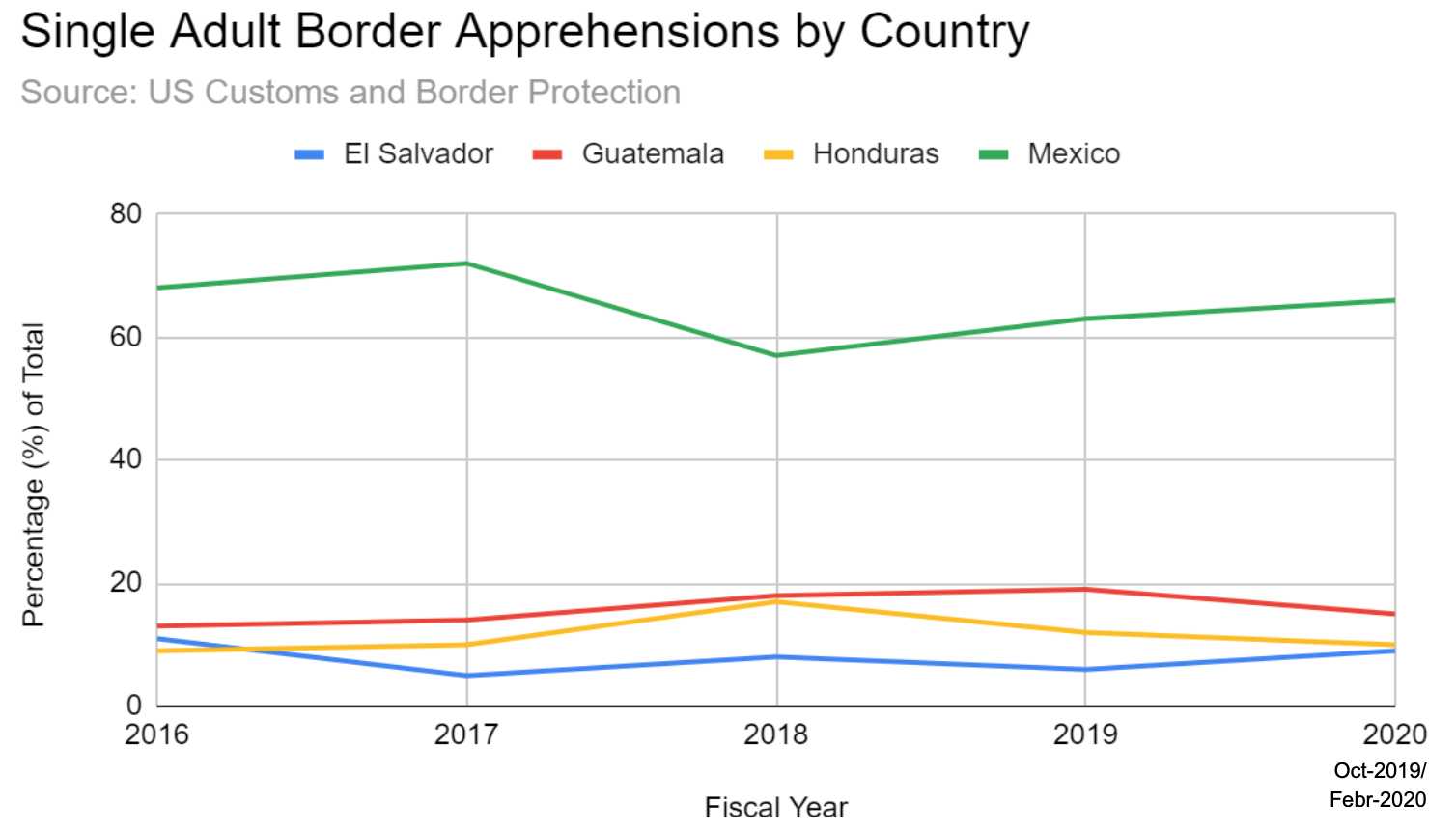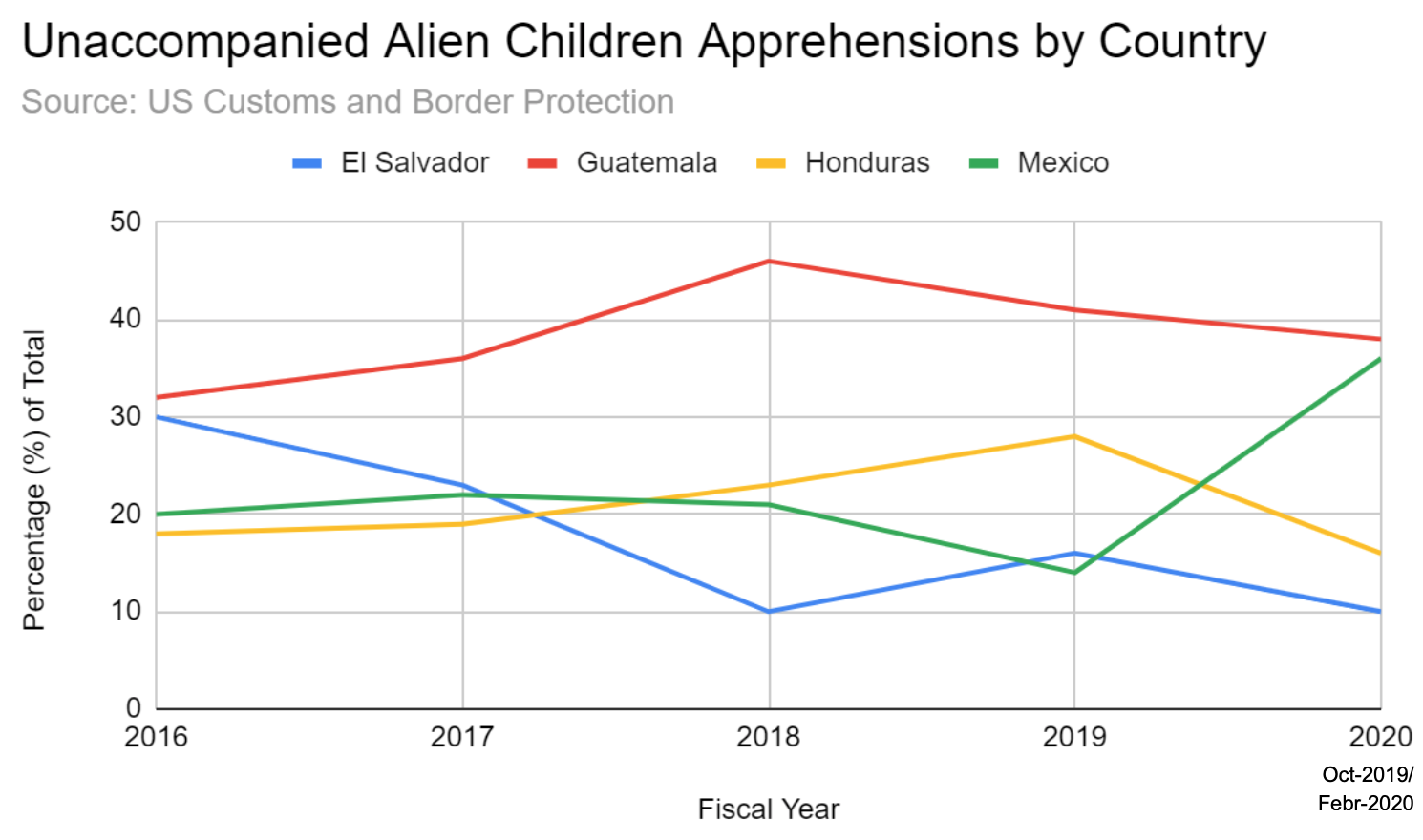The Trump Administration's Newest Migration Policies and Shifting Immigrant Demographics in the USA
New Trump administration migration policies including the "Safe Third Country" agreements signed by the USA, Guatemala, El Salvador, and Honduras have reduced the number of migrants from the Northern Triangle countries at the southwest US border. As a consequence of this phenomenon and other factors, Mexicans have become once again the main national group of people deemed inadmissible for asylum or apprehended by the US Customs and Border Protection.
![An US Border Patrol agent at the southwest US border [cbp.gov]. An US Border Patrol agent at the southwest US border [cbp.gov].](/documents/10174/16849987/migracion-mex-blog.jpg)
▲ An US Border Patrol agent at the southwest US border [cbp.gov].
ARTICLE / Alexandria Casarano Christofellis
On March 31, 2018, the Trump administration cut off aid to the Northern Triangle countries in order to coerce them into implementing new policies to curb illegal migration to the United States. El Salvador, Honduras, and Guatemala all rely heavily on USAid, and had received 118, 181, and 257 million USD in USAid respectively in the 2017 fiscal year.
The US resumed financial aid to the Northern Triangle countries on October 17 of 2019, in the context of the establishment of bilateral negotiations of Safe Third Country agreements with each of the countries, and the implementation of the US Supreme Court's de facto asylum ban on September 11 of 2019. The Safe Third Country agreements will allow the US to 'return' asylum seekers to the countries which they traveled through on their way to the US border (provided that the asylum seekers are not returned to their home countries). The US Supreme Court's asylum ban similarly requires refugees to apply for and be denied asylum in each of the countries which they pass through before arriving at the US border to apply for asylum. This means that Honduran and Salvadoran refugees would need to apply for and be denied asylum in both Guatemala and Mexico before applying for asylum in the US, and Guatemalan refugees would need to apply for and be denied asylum in Mexico before applying for asylum in the US. This also means that refugees fleeing one of the Northern Triangle countries can be returned to another Northern Triangle country suffering many of the same issues they were fleeing in the first place.
Combined with the Trump administration's longer-standing "metering" or "Remain in Mexico" policy (Migrant Protection Protocols/MPP), these political developments serve to effectively "push back" the US border. The "Remain in Mexico" policy requires US asylum seekers from Latin America to remain on the Mexican side of the US-Mexico border to wait their turn to be accepted into US territory. Within the past year, the US government has planted significant obstacles in the way of the path of Central American refugees to US asylum, and for better or worse has shifted the burden of the Central American refugee crisis to Mexico and the Central American countries themselves, which are ill-prepared to handle the influx, even in the light of resumed US foreign aid. The new arrangements resemble the EU's refugee deal with Turkey.
These policy changes are coupled with a shift in US immigration demographics. In August of 2019, Mexico reclaimed its position as the single largest source of unauthorized immigration to the US, having been temporarily surpassed by Guatemala and Honduras in 2018.


US Customs and Border Protection data indicates a net increase of 21% in the number of Unaccompanied Alien Children from Mexico, Guatemala, Honduras, and El Salvador deemed inadmissible for asylum at the Southwest US Border by the US field office between fiscal year 2019 (through February) and fiscal year 2020 (through February). All other inadmissible groups (Family Units, Single Adults, etc.) experienced a net decrease of 18-24% over the same time period. For both the entirety of fiscal year 2019 and fiscal year 2020 through February, Mexicans accounted for 69 and 61% of Unaccompanied Alien Children Inadmissible at the Southwest US border respectively, whereas previously in fiscal years 2017 and 2018 Mexicans accounted for only 21 and 26% of these same figures, respectively. The percentages of Family Unit Inadmisibles from the Northern Triangle countries have been decreasing since 2018, while the percentage of Family Unit Inadmisibles from Mexico since 2018 has been on the rise.
With asylum made far less accessible to Central Americans in the wake of the Trump administration's new migration policies, the number of Central American inadmisibles is in sharp decline. Conversely, the number of Mexican inadmisibles is on the rise, having nearly tripled over the past three years.
Chain migration factors at play in Mexico may be contributing to this demographic shift. On September 10, 2019, prominent Mexican newspaper El discussion published an article titled "Immigrants Can Avoid Deportation with these Five Documents." Additionally, The Washington Post cites the testimony of a city official from Michoacan, Mexico, claiming that a local Mexican travel company has begun running a weekly "door-to-door" service line to several US border points of entry, and that hundreds of Mexican citizens have been coming to the municipal offices daily requesting documentation to help them apply for asylum in the US. Word of mouth, press coverage like that found in El discussion, and the commercial exploitation of the Mexican migrant situation have perhaps made migration, and especially the claiming of asylum, more accessible to the Mexican population.
US Customs and Border Protection data also indicates that total apprehensions of migrants from Mexico, Guatemala, Honduras, and El Salvador attempting illegal crossings at the Southwest US border declined 44% for Unaccompanied Alien Children and 73% for Family Units between fiscal year 2019 (through February) and fiscal year 2020 (through February), while increasing for Single Adults by 4%. The same data trends show that while Mexicans have consistently accounted for the overwhelming majority of Single Adult Apprehensions since 2016, Family Unit and Unaccompanied Alien Children Apprehensions until the past year were dominated by Central Americans. However, in fiscal year 2020-February, the percentages of Central American Family Unit and Unaccompanied Alien Children Apprehensions have declined while the Mexican percentage has increased significantly. This could be attributed to the Northern Triangle countries' and especially Mexico's recent crackdown on the flow of illegal immigration within their own states in response to the same US sanctions and suspension of USAid which led to the Safe Third Country bilateral agreements with Guatemala, Honduras, and El Salvador.
While the Trump administration's crackdown on immigration from the Northern Triangle countries has effectively worked to limit both the legal and illegal access of Central Americans to US entry, the Trump administration's crackdown on immigration from Mexico in the past few years has focused on arresting and deporting illegal Mexican immigrants already living and working within the US borders. Between 2017 and 2018, ICE increased workplace raids to arrest undocumented immigrants by over 400% according to The Independent in the UK. The trend seemed to continue into 2019. President Trump tweeted on June 17, 2019 that "Next week ICE will begin the process of removing the millions of illegal aliens who have illicitly found their way into the United States. They will be removed as fast as they come in." More deportations could be leading to more attempts at reentry, increasing Mexican migration to the US, and more Mexican Single Adult apprehensions at the Southwest border. The Washington Post alleges that the majority of the Mexican single adults apprehended at the border are previous deportees trying to reenter the country.


Lastly, the steadily increasing violence within the state of Mexico should not be overlooked as a cause for continued migration. Within the past year, violence between the various Mexican cartels has intensified, and murder rates have continued to rise. While the increase in violence alone is not intense enough to solely account for the spike that has recently been seen in Mexican migration to the US, internal violence nethertheless remains an important factor in the Mexican migrant situation. Similarly, widespread poverty in Mexico, recently worsened by a decline in foreign investment in the light of threatened tariffs from the USA, also plays a key role.
In conclusion, the Trump administration's new migration policies mark an intensification of long-standing nativist tendencies in the US, and pose a potential threat to the human rights of asylum seekers at the US-Mexico border. The corresponding present demographic shift back to Mexican predominance in US immigration is driven not only by the Trump administration's new migration policies, but also by many other diverse factors within both Mexico and the US, from press coverage to increased deportations to long-standing cartel violence and poverty. In the face of these recent developments, one thing remains clear: the situation south of the Rio Grande is just as complex, nuanced, and constantly evolving as is the situation to the north on Capitol Hill in the USA.